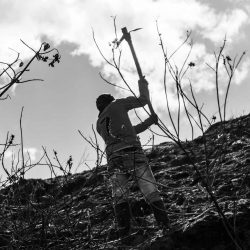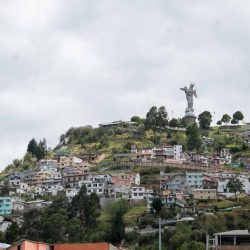This is a rather uncomfortable position. I am glued against a rock, with my right foot firmly planted on one of the few uneven spots that can support my weight. My right hand is struggling to get a hold, the other two limbs are in No Man’s Land. Beneath me is nothing, for at least ten metres. There seems to be no way forward, nor back, and I slowly start to slide…
It must be a rather sad sight, this forty-something in his red windbreaker jacket falling down in slow-motion. It’s not steep enough for an immediate hard fall, but gravity is slowly doing its work as my right hand has to let go as well.
All of a sudden a hand comes from higher up the rock. He grabs my right five fingers, and somehow manages to lift them up to a point with grip. I creep up the rock by own force, until the guy can grab my left hand as well to lift me all the way up. He tells me where to put my left foot as well, a spot I hadn’t noticed before. And that one step takes me over the last hurdle, to the other side of the rock. And from here, I still remember from my way up, it’s easy enough to make it back to the elevator.
‘I told the authorities last year already they should put a steel cable here for support’, he says, with an unmistakenably French accent. But, obviously, they did not. ’I see people here struggling every time.’
Actually I had witnessed the exact same awkward thing ten minutes earlier, on that other notorious spot on the walk up (and down). And the problem wasn’t down to age, as this had been a fit teenager, with his legs spread out against the rock wall and desperately searching for grip. If it hadn’t been generous me, he probably would have fallen as well. Though nobody in the end did on this day, it seems.
It was not supposed to be so hard. There were of course other hurdles expected. Not at least the altitude, as Rucu Pichincha’s summit was at around 4’700 metres. But from down in the valley, in the bustling metropolis of Quito itself, it was hard to understand how treacherous it could get.
I had been in the capital of Ecuador for several days already, so had gotten used to its elevation of around 2’900 metres. Besides, in the previous two weeks Puebla and Mexico City had been my previous two stations, at a similar altitude. And the weather in the Quito valley had been stable in those days. Slightly chilly, yes, but nothing coming close to a threatening storm.
Maybe one of the deceptive parts of Rucu Pichincha as well is that the first part is so easy. The cable cars of the Teleferico are at the northern edge of town. It’s an easy taxi ride there. I could even grab a coffee before getting a ticket, and after a local had cursed at me for not washing my hands outside. I pointed at my antibacterial gel I had used shortly before, but reason was beyond reach in the communication with this guy, who in his balaclava and facemask seemed to be slightly overcautious to me.

The cable cars then whisk you up to around 4’000 metres within ten minutes. This is that short period of eerie silence. There are no motors around, only the sound of the wind, interrupted only by the sound of the wheels at one of the supporting masts on the way up. The city that looked so massive only shortly before, slowly shrinks and gets flatter and flatter. The mountain, in the meantime, gets steeper and steeper.
For inhabitants of Quito this is one of their favorite weekend getaways. It’s a kick-ass adventure for the kids (I slightly adjusted my writing style in this sentence to accommodate the younger generation). Once up the Teleferiqo, there is a relatively flat plateau where one can walk around. There is a swing that brings you awkwardly close to the edge, provides you with spine-chilling views and the best Instagram pictures you could wish for. A bit further up the edge is a viewpoint, where Quito turns out to have become quite small indeed.
Plenty to do for kids therefore, but I only discover that on my way back, as my ever-restless soul missed the signs pointing towards the mirador when I disembarked the cabin. Instead there is an obvious trail in front of me. And further up the road is already the unmistakenable contour of Rucu Pichincha.
It’s not by any means the highest volcano of the country. But because of its proximity to the capital, and therefore its accessibility, it might be the most popular summit of Ecuador. As this friday is a national holiday, it’s easy to see why: dozens of families take the Teleferiqo to get some great views, hundreds of local hikers put on their Alpine gear to walk.
You need that gear, Because at this elevation, there is hardly a tree in sight. The trail, which bends slightly to the right to correct my initial navigation mistake, gets more and more barren. The vegetation gets more and more sparse as well. Nothing here survives over a height of one metre. Spectacular colors seem impossible to grow here. There are three or four species with orange or purple leaves, though those leaves look more like they could sting the relentless wind than be smooth on your skin when you touch them.
On the other side of the valley the mountain glows in several shades of brown. If the sound of the wind wouldn’t betray the scenery, it would look idyllic. The last view of Quito indicates the sun is shining there still. But here the clouds gather and gather above us.

It’s not exactly the first hike of my life. During my previous trip I had hiked the Santa Ana volcano in Guatemala on my own. That had been a scary experience, getting lost in the steep climb, getting completely stuck in vegetation and thinking a helicopter would probably have to pick me up from the mountain. It all ended well, by a combination of logical thinking and luck. But that nightmare also makes me think that Rucu Pichincha seems pretty easy.
And actually, it is. For the first ninety minutes. The trail goes steadily but smoothly up. Signposts tell you your progress, altitude-wise. At 4’309 metres, I can later tell by the pictures, there is plenty of energy to take pictures from the jaw-dropping skyline of the Rucu Pichincha. And as the trail winds around the corner, the first heavy gushes of wind blowing in my face, all still seems alright.
But that’s the part where pleasure stops and problems start. The trail still is comfortable. But there are these two stretches of slight rock-climbing that are deceptively difficult. They don’t form a stairs, so you can’t use your weight to climb up. It’s more of a horizontal passage, alternativeless because there is no trail around and below the rock is just an abyss. Well, not a drop of several hundred metres, but one that is still deep enough and with uncertain chances of survival.
The first passage I survive more by luck than skill. Not that this stretch is impossible, in the weekends hundreds of people pass here somehow. But experience with rock-climbing I hardly have. And, more important, I am on my own. Which robs me of the extra hand to lift me over the difficult spots.
The second stretch therefore I play nice with a bunch of locals. A slender guy in shorts, and three girls whom he seems to want to impress. I play straight with the girls, who are also obviously far outside their comfort zone. But foot by foot we make it along this second rock as well. How we get back is of a later worry.
It turns out it is by no means the last difficult bit. Actually, the first 80% is a piece of cake. The last part, though, is everything you would hope not to encounter on a hike.
The final ascent starts with a strange landscape. It seems to be a hill of pulverized light-colored sand. There is hardly any firm support to find. So some choose to go straight up, at a pace where you don’t wait for firm support and assume that the sand itself can give you enough stability for the next step. But that is way too strenuous for me, and my four new friends, at this height.
We opt for what is left of the trail, an awkward, also rather unstable climb on the right side of the sandy part. The wind has picked up. First raindrops start to batter my windbreaker jacket, which I put on over my fleece jacket which I needed at 4’309 metres which I put over my T-shirt I started with down in Quito. Now the last line of defense, a rain jacket, needs to be uncovered from the backpack.
Every couple of metres I need a break now. The lack of oxygen is palpable but hard to describe. It’s more like a slow killer, you only notice it when it is too late. I don’t want to take it that far. After a hard thirty minutes of climbing, I finally take some rest on a ridge. From here, at more than 4’600 metres, you can look to the other side of the mountain. The clouds are just above us and are coming down. A dog besides me is aiming for my lunch. Which, of course, is a hopeless mission.
On the left side seems to be the final ascent of the final ascent. The three girls from the group return, it’s too hard. A sign says ‘25 minutes to the top’, an arrow pointing to a rock where no trail is visible and climbing seems to be the only modus operandi.
The rain intensifies, and I take a rare wise decision. With the clouds hovering lower and lower, it’s likely there aren’t even any views from the top, fifty metres higher. Rain will make the rocky parts going up and down even more tricky. And my energy levels seem to suffice for going down, but not for going first a bit further up.
So step by step I go down. Not admitting defeat, because there is no heroism in getting injured or worse on a mountain. Persevering despite rationality telling you you are on a mission impossible is far worse, the type of masculinity I learned to loathe.
The sandy part is treacherous but on the way down relatively short. Then comes the intermittent easy part, before the first rock where I save the young guy and wonder how he could have gotten into such trouble. Five minutes later I myself hang on another rock, helplessly, only to be rescued by a stranger.
There is no use for the ’what if’ question. Rucu Pichincha has been an awesome experience. And I didn’t loose. I went higher than ever before in my life. The rain gushing down on me on the way to the Teleferiqo proves the wisdom of my decisions. Once back down in Quito, the sun gently shines again and there is not a sign of the danger up above.
Good to know:
- more info about the Teleferico: official site





